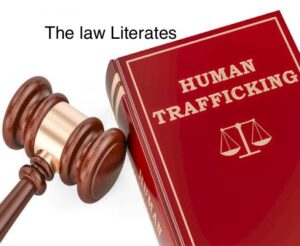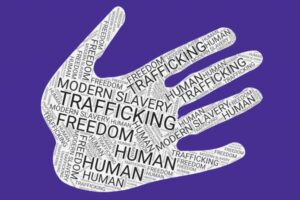human trafficking in India is the Immoral Traffic (Prevention) Act, 1956 (ITPA)/Laws/National & International Laws/Complication/Blogs
Human trafficking/ laws / Famous Cases/ Complication
Human trafficking is a form of modern-day slavery where individuals are exploited for labor or commercial sex through the use of force, fraud, or coercion. Human trafficking can take many different forms, such as:
Forced labor: Individuals are forced to work without pay or under inhumane conditions, often in industries such as agriculture, construction, domestic work, or manufacturing.
Sex trafficking: Individuals are forced to engage in commercial sex acts, such as prostitution or pornography.
Child trafficking: Children are forced into labor or commercial sex acts.
Debt bondage: Individuals are forced to work in order to pay off a debt that they cannot realistically repay.
Forced marriage: Individuals are forced into a marriage against their will.
Human trafficking is a global issue that affects millions of people worldwide. It is often linked to other crimes, such as drug trafficking, arms trafficking, and money laundering. Governments, NGOs, and international organizations are working to prevent human trafficking, protect victims, and prosecute traffickers.
Laws
Human trafficking is a serious crime in India, and it is addressed by various laws and regulations at the national and state levels.
The primary law that deals with human trafficking in India is the Immoral Traffic (Prevention) Act, 1956 (ITPA). This act was enacted to prohibit the trafficking of women and girls for commercial sexual exploitation and to provide for the rehabilitation of victims. The ITPA was amended in 2018 to address issues related to trafficking of men and children, forced labor, and online exploitation.
In addition to the ITPA, other laws that address human trafficking in India include:
The Protection of Children from Sexual Offences (POCSO) Act, 2012, which provides for the protection of children from sexual abuse and exploitation, including trafficking.
The Bonded Labour System (Abolition) Act, 1976, which prohibits bonded labor and provides for the punishment of offenders.
The Juvenile Justice (Care and Protection of Children) Act, 2015, which provides for the care, protection, and rehabilitation of children who are victims of trafficking.
The Prevention of Money Laundering Act, 2002, which criminalizes the laundering of proceeds from trafficking and other crimes.
India has also signed and ratified several international conventions and protocols related to human trafficking, including the UN Convention against Transnational Organized Crime and its Protocol to Prevent, Suppress and Punish Trafficking in Persons, Especially Women and Children.
Famous cases related to human trafficking
There have been several high-profile cases of human trafficking in India over the years. Here are a few notable ones:
Suryanelli sex scandal: In 1996, a 16-year-old girl from Suryanelli in Kerala was abducted and sexually assaulted by a bus conductor, who then sold her to various men for 40 days. The case became a scandal as several high-profile people were implicated, including politicians and businessmen.
Baby Falak: In 2012, a two-year-old girl named Falak was admitted to a hospital in Delhi with severe injuries, including a fractured skull and bite marks all over her body. It was later revealed that she had been sold multiple times and subjected to physical and sexual abuse. The case led to widespread outrage and calls for stronger laws against human trafficking.
Sonagachi case: In 2016, a sex trafficking racket was busted in Sonagachi, Kolkata’s largest red-light district. The police rescued 25 girls and arrested several people, including a woman who ran the brothel and a man who acted as a pimp.
Nirbhaya case: The infamous 2012 Delhi gang-rape case also had elements of human trafficking. The victim, a 23-year-old medical student, was lured onto a bus by a group of men, who then gang-raped and tortured her. One of the perpetrators was reportedly a trafficker who had promised the victim a job before abducting her.
Operation Muskaan: This was a nationwide rescue operation conducted by the Indian police in 2019, in which over 15,000 children were rescued from various forms of exploitation, including trafficking. The operation was conducted over a period of two months and covered all 29 states of India.
Human trafficking is a complex issue that can have far-reaching and long-lasting effects on individuals, communities, and societies. Here are some of the complications associated with human trafficking:
Physical and emotional trauma: Trafficked individuals may experience physical and emotional trauma, including physical abuse, sexual violence, and psychological trauma. These experiences can have long-term effects on the individual’s health and well-being.
Social stigma: Trafficked individuals may face social stigma and discrimination due to the nature of their exploitation, which can lead to isolation and further trauma.
Legal challenges: Trafficked individuals may face legal challenges in accessing justice and seeking redress, as they may not have legal status or may fear retribution from their traffickers.
Economic impact: Trafficked individuals may face significant economic challenges, as they may have lost their livelihoods, be in debt bondage, or be unable to access formal employment due to their legal status or lack of education.
Interconnectedness with other crimes: Human trafficking is often interconnected with other crimes, such as money laundering, drug trafficking, and terrorism, which can make it difficult to investigate and prosecute.
Transnational nature: Human trafficking is a transnational crime that often involves multiple jurisdictions, which can make coordination and cooperation between law enforcement agencies challenging.
Lack of awareness: Many people may not be aware of the signs of human trafficking or the scale of the problem, which can hinder efforts to prevent trafficking and protect victims.
laws and regulations at the national and international levels
Human trafficking is a serious crime that is addressed by various laws and regulations at the national and international levels. Here are some of the key laws related to human trafficking:
The UN Protocol to Prevent, Suppress and Punish Trafficking in Persons, Especially Women and Children, which supplements the UN Convention against Transnational Organized Crime. The Protocol provides a comprehensive definition of human trafficking and sets out measures to prevent and combat the crime, protect and assist victims, and promote cooperation among states.
The US Trafficking Victims Protection Act (TVPA), which sets out measures to prevent human trafficking, protect and assist victims, and prosecute offenders. The TVPA also includes provisions on forced labor, child labor, and sex trafficking.
The European Union Directive on preventing and combating trafficking in human beings and protecting its victims, which sets out measures to prevent trafficking, protect and assist victims, and prosecute offenders.
The Immoral Traffic (Prevention) Act, 1956 (ITPA) in India, which prohibits trafficking of women and girls for commercial sexual exploitation and provides for the rehabilitation of victims. The ITPA was amended in 2018 to address issues related to trafficking of men and children, forced labor, and online exploitation.
The Palermo Protocol, which is a supplement to the UN Convention against Transnational Organized Crime, and includes provisions on human trafficking, smuggling of migrants, and the use of false documents.
The Criminal Code of Canada, which includes provisions on human trafficking, forced labor, and child prostitution.
The Modern Slavery Act 2015 in the United Kingdom, which includes provisions on forced labor, human trafficking, and slavery.
These laws, along with other national and international instruments, aim to prevent human trafficking, protect and assist victims, and prosecute offenders. They also highlight the importance of international cooperation in addressing the crime of human trafficking.
Adv Vaibhav Tomar (All Rights Reserved)
it’s my opinion



